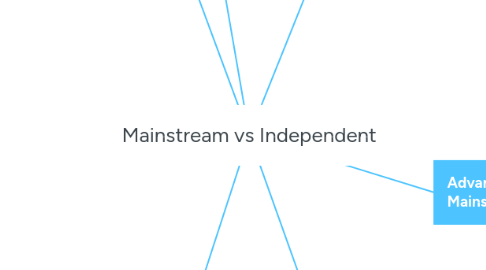
1. Ways fans can access info on the band
1.1. One Direction
1.1.1. Official website
1.1.1.1. Onedirectionmusic.com
1.1.2. Wikipedia
1.1.3. YouTube
1.1.3.1. One direction VEVO
1.1.4. TV
1.1.5. Magazines
1.1.6. Posters
1.1.7. Social media
1.1.7.1. Their instagram account has 17.3 million followers
1.2. Lanterns On The Lake
1.2.1. Official website
1.2.1.1. Lanternsonthelake.com
1.2.2. Wikipedia
1.2.3. Youtube
1.2.4. Social media
1.2.4.1. They have a much smaller following with only 1258 instagram followers
2. Independent
2.1. Lanterns On The Lake
2.1.1. A five person indie rock band composed of: Hazel Wilde, Paul Gregory, Oliver Ketteringham, Bob Allan, and Angela Chan formed in 2007
2.1.1.1. Signed by Bella Union
2.1.1.2. They have played a number of festivals like
2.1.1.2.1. Bestival
2.1.1.2.2. SXSW
2.1.1.2.3. Glastonbury
2.1.2. Bella Union
2.1.2.1. A British independent record label founded in 1997 by Simon Raymonde.
2.1.2.2. Specialises in Indie rick, Alternative rock, Folk, Experimental, and Psychedelic music
2.1.2.3. Other artists signed to Bella Union
2.1.2.3.1. I hadn't heard of many of the artists signed to Bella Union except
2.1.3. Target audience
2.1.3.1. They are too small of a band to have a Yougov profile but their fans are older than what is expected of One Direction fans so around their early to mid twenties.
2.1.4. Their website is laternsonthelake.com
2.1.4.1. Most of their music is available digitally
2.1.4.1.1. This bus probably to help the label save money
2.1.4.1.2. Although they do sell vinyls on the website
2.1.4.2. They sell a lot of merchandise in the form of artwork and posters as well as prints and tshirts
2.1.4.2.1. However the range is much more limited than that of One Direction
3. Mainstream
3.1. One Direction
3.1.1. Target audience
3.1.2. Made up of Niall Horan, Liam Payne, Harry Styles, Louis Tomlinson, and Zayn Malik until his departure from the band in 2015.
3.1.2.1. Signed by Syco and Columbia records
3.1.3. They were formed in 2010 after all auditioning individually for the X Factor
3.1.4. Their website is onedirectionmusic.com
3.1.4.1. Here fans can buy a variety of merchandise such as:
3.1.4.1.1. Albums
3.1.4.1.2. DVDs
3.1.4.1.3. Perfumes
3.1.4.1.4. Jewellery
3.1.4.1.5. Tshirts
3.1.4.2. You can also digitally download their music from a range of outlets such as
3.1.4.2.1. Itunes
3.1.4.2.2. Apple Music
3.1.4.2.3. Spotify
3.1.4.2.4. Amazon
3.1.4.2.5. HMV
3.1.4.2.6. TIDAL
3.1.5. Columbia Records
3.1.5.1. This label signs some of the biggest names in music including:
3.1.5.1.1. Beyonce
3.1.5.1.2. Adele
3.1.5.1.3. Katy Perry
3.1.5.1.4. Shakira
3.1.5.1.5. The chainsmokers
3.1.5.1.6. J. Cole
3.1.5.1.7. John legend
3.1.5.1.8. Daft punk
3.2. Syco
3.2.1. A British record label owned by Simon Cowell that is distributed through Sony Music.
3.2.2. Yougov profiler says that the target audience is women between the ages of 18 and 24
3.2.2.1. But I believe that its closer to 10-17
3.2.3. It has the exclusive right to sign any winner or finalist of the X factor or Got Talent shows
3.2.4. Other artists signed by Syco:
3.2.4.1. Little Mix
3.2.4.2. Camilla Cabello
3.2.4.3. Ella Henderson
3.2.4.4. Noah Cyrus
3.2.4.5. Fifth Harmony
3.2.4.6. Labrinth
3.2.4.7. Grace Vanderwaal
3.2.5. Specialises in pop artists/music
4. Advantages & Disadvantages of Independent Labels
4.1. Advantages
4.1.1. Artists have much more creative freedom
4.1.1.1. Labels aren't forced to push out hit after hit and so artists are free to do more of what they want
4.1.2. Artists have the rights to their own music
4.1.2.1. They can choose to do whatever they want with their songs after they're are produced
4.1.2.1.1. A lot of independently produced songs are used in adverts
4.1.3. There's no pressure on the label to sign a specific sign or look so they have more respect for the music
4.1.4. A smaller roster means artists dint have to fight for their place at the label
4.1.5. Artists often make a higher royalty percentage
4.1.6. Artists are almost never locked into multi album deals
4.2. Disadvantages
4.2.1. Artists have to remain financially invested in their careers
4.2.2. Smaller labels don't have the purchasing power or the influence that mainstream labels have
4.2.3. These labels are able pull fewer strings with the media
5. Advantages & Disdavantages of Mainstream Labels
5.1. Advantages
5.1.1. Excessive funds
5.1.1.1. Can fund high quality production, global physical and digital distribution, world tours and music videos
5.1.2. Networking
5.1.2.1. Major labels have a lot of connections over many different industries
5.1.3. Size and reputation
5.1.3.1. Helps to make deals with big names in the industry, rolling stone for example
5.1.3.1.1. Which a small label could not
5.2. Disadvantages
5.2.1. Big pond, small fish
5.2.1.1. Major labels sign a lot of artists and throw out a lot of music just to see what catches on. This means that artists have to fight for the attention of producers to further their careers
5.2.2. People are turned over very often in these companies, not just including artists
5.2.3. Artists can often be stuck in multi album deals with very little flexibility
5.2.3.1. Example: Kesha vs Dr Luke and Sony
5.2.3.2. The bargaining power is not on the artists side as the labels have more money and power (and better lawyers)
5.2.4. Artists may be forced to make music that contradicts with their morals or artistic style
5.2.4.1. Example: Halsey making a song with Quavo
6. Importance merchandise and ancillary markets
6.1. To Mainstream artists
6.1.1. Not the most important aspect in their success
6.1.2. Labels have enough money to not have to rely solely on ancillary profits
6.2. Artists make a lot of money from merchandising and ancillary products. These help to give the artist exposure. Choosing the right ancillary product wiki helps artists to target the right people (for example younger generations are more likely to purchase digita;l downloads of music whereas older generations are more likely to buy cds)
6.3. To Independent artists
6.3.1. Profits from merchandise play a much bigger role to indie artists.
6.3.2. Merch helps to promote the artists
6.3.3. As Independent labels have less funding this money is much more important than to mainstream labels
